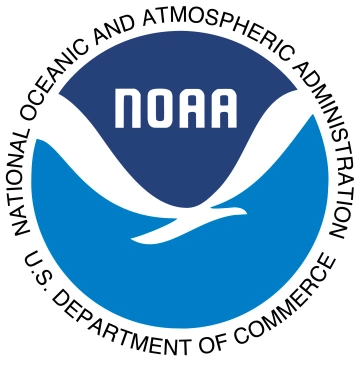< Back to Climate Viticulture Newsletter
Hello, everyone!
This is the June 2025 issue of the Climate Viticulture Newsletter – a quick look at some timely climate topics relevant to wine grape growing in Arizona.
IN THIS ISSUE
- A Recap of May Temperature and Precipitation
- The Outlook for June Temperature and Precipitation
- Heat Accumulation during the Growing Season
- Extra Notes
A Recap of May Temperature and Precipitation
Monthly average temperatures were near the 1991-2020 normal for much of the state (white areas on map), including all three Arizona AVAs. Otherwise, scattered areas measured temperatures 1 to 3 °F above and below normal (light orange and orange, light blue and blue areas on map, respectively). For reference, monthly average temperatures in May last year were within 2 °F of normal for almost all of the state.
Area-average maximum and minimum temperatures during May 2025 were 80.9 and 50.3 °F for the Sonoita AVA, 84.8 and 51.0 °F for the Verde Valley AVA, and 83.6 and 49.3 °F for the Willcox AVA. Respective May normals are 81.7 and 49.6 °F, 84.5 and 50.0 °F, and 84.8 and 48.9 °F.
Temperature last month ranged between 94.5 and 40.1 °F at the AZMet Bonita station and between 96.3 and 39.6 °F at the AZMet Willcox Bench station.
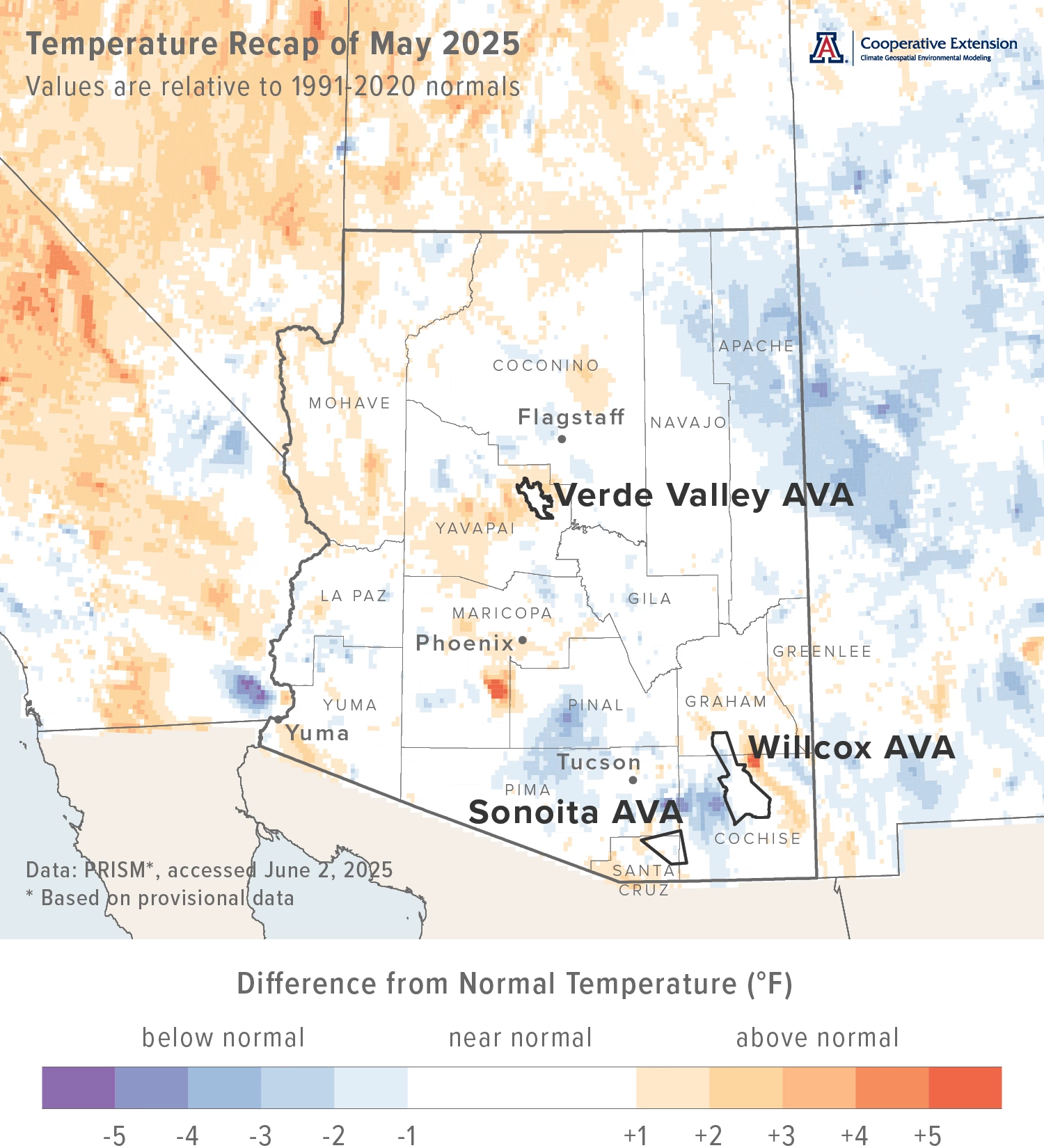
Jeremy Weiss
Monthly precipitation totals were more than 250 % of normal for much of the west-central part of the state (dark blue areas on map). Nearby, amounts in Verde Valley AVA were mostly between 150 and 250 % of normal (aqua, dark aqua, aqua-blue, and blue areas on map). In contrast, much of the southeastern quarter of Arizona saw totals less than 75 % of normal (light yellow, yellow, and dark yellow areas on map), including the Sonoita and Willcox AVAs. Amounts were near normal for much of the northwestern corner of the state (white areas on map). Precipitation during May 2024 was less than 25 % of normal for almost all of Arizona.
Area-average total precipitation in May 2025 was 0.01 inches for the Sonoita AVA, 0.83 inches for the Verde Valley AVA, and 0.04 inches for the Willcox AVA. Respective May normals are 0.22, 0.44, and 0.29 inches.
Total precipitation last month was 0.00 and 0.00 inches at the AZMet Bonita and Willcox Bench stations, respectively.
Dig further into daily weather summaries for the AZMet Bonita and Willcox Bench stations in the Willcox AVA
Learn more about PRISM climate data
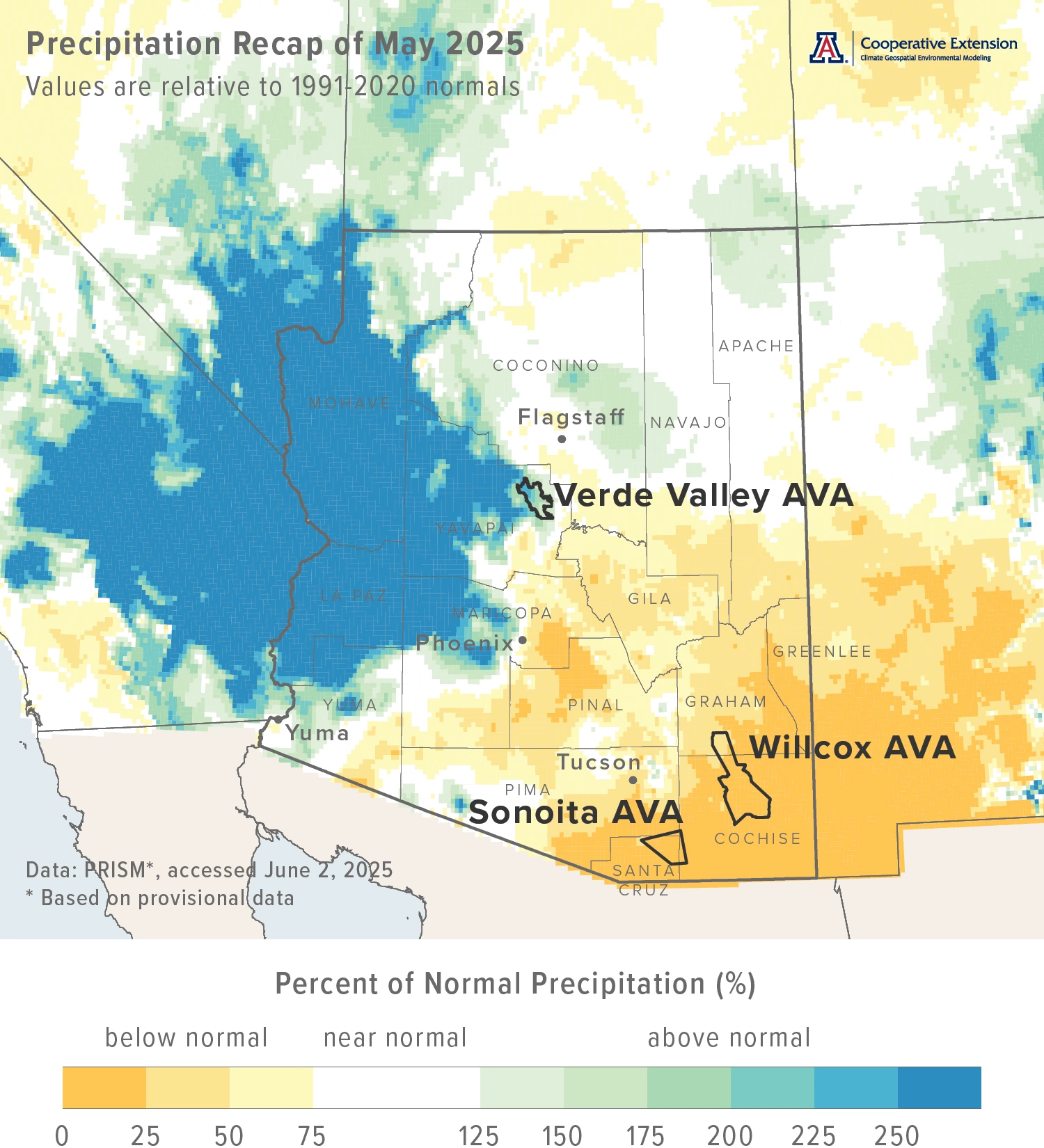
Jeremy Weiss
The Outlook for June Temperature and Precipitation
Temperatures over the course of this month have a slight increase in chances for being above the 1991-2020 normal across all of Arizona (orange area on map). Monthly average temperatures in June last year were 2 to 4 °F above normal for much of the southeastern half of the state, and more than 4 °F for much of the northwestern half.
Area-average maximum and minimum temperatures during June 2024 were 92.8 and 61.8 °F for the Sonoita AVA, 99.6 and 64.5 °F for the Verde Valley AVA, and 96.1 and 62.0 °F for the Willcox AVA. Respective June normals are 90.6 and 59.0 °F, 95.4 and 58.4 °F, and 94.5 and 59.1 °F.
Temperature in June last year ranged between 103.1 and 51.4 °F at the AZMet Bonita station and between 103.6 and 52.9 °F at the AZMet Willcox Bench station.
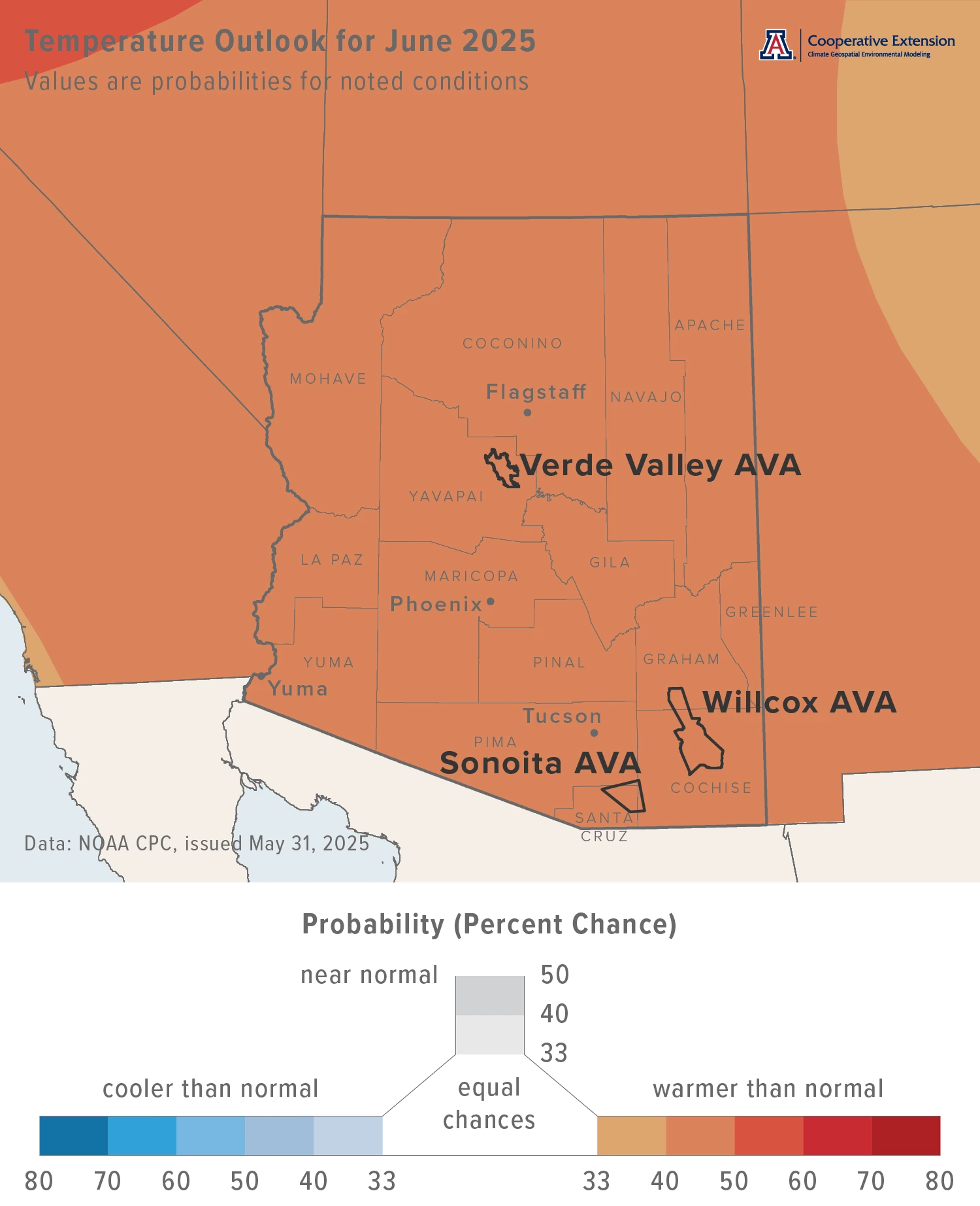
Jeremy Weiss
Precipitation totals for this month have a slight increase in chances for being above normal over the extreme southeastern corner and along the western border of the state (lighter aqua areas on map). For the rest of Arizona, chances for above-normal rainfall are moderate (darker aqua areas on map). Please keep in mind that this reflects more the recent rain from a cut-off low pressure system that brought moisture from tropical depression Alvin into the state than an early start to the monsoon. The latter still cannot be counted out, however. With a relatively early start to the monsoon, precipitation during June 2024 was more than 200 % of normal for many parts of the state.
Area-average precipitation totals in June 2024 were 1.64 inches for the Sonoita AVA, 0.93 inches for the Verde Valley AVA, and 1.06 inches for the Willcox AVA. Respective June normals are 0.55, 0.18, and 0.42 inches.
Total precipitation in June last year was 0.67 and 1.75 inches at the AZMet Bonita and Willcox Bench stations, respectively.
To stay informed of long-range temperature and precipitation possibilities beyond the coverage of a standard weather forecast, check in, too, with the six-to-ten-day outlook and eight-to-fourteen-day outlook issued daily by NOAA’s Climate Prediction Center.
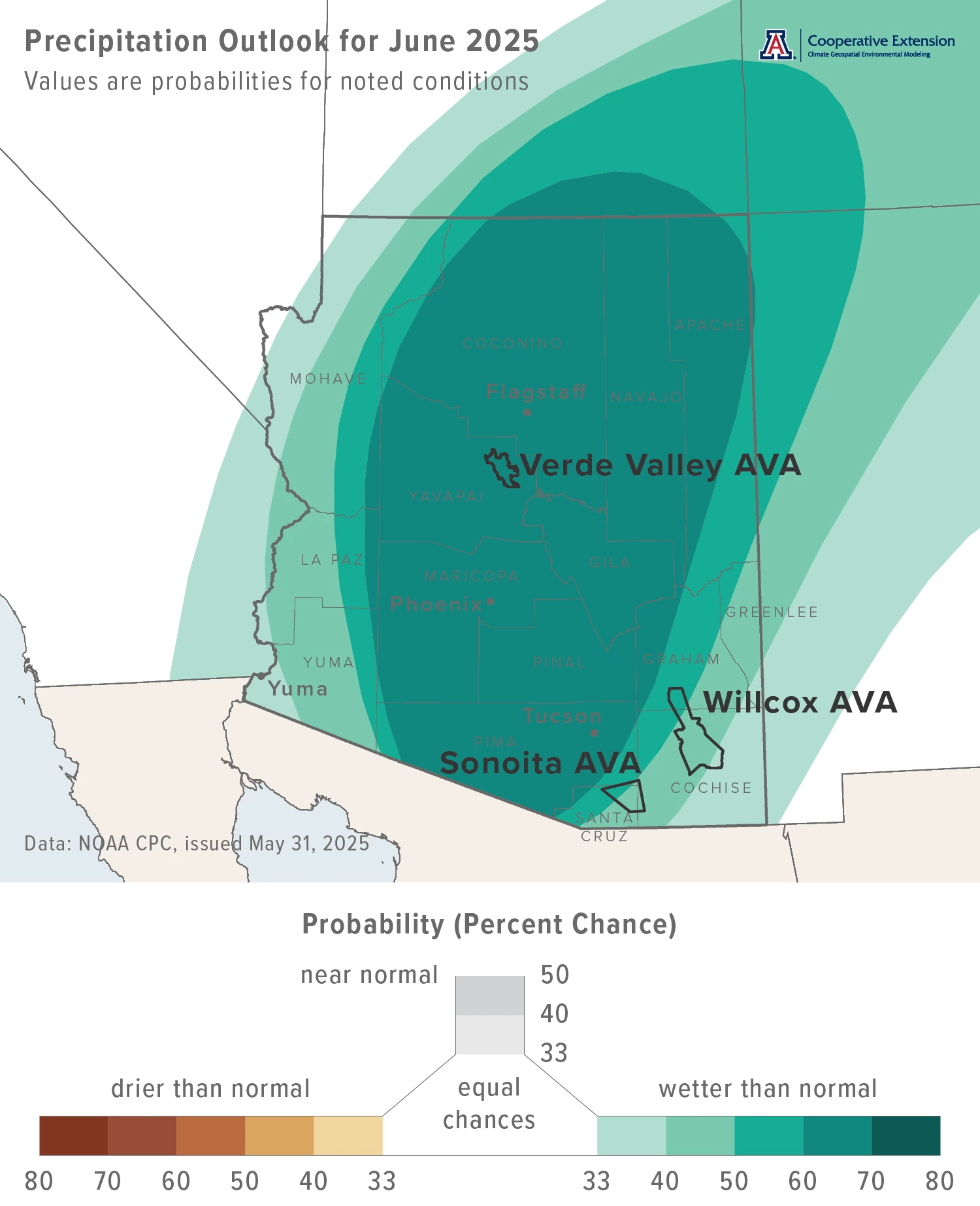
Jeremy Weiss
Heat Accumulation during the Growing Season
Heat accumulation from April through May this year at the AZMet Willcox Bench station in the south-central part of the Willcox AVA is greater than what it was at this time last year (top two rows of table). This suggests that the growth rate of vines may have been faster and the time between pre-veraison growth stages shorter so far this growing season than what they were in the previous one. Heat accumulation in both years is below average, as indicated by the negative percent values in the third table column.
Relative to last year, how much more advanced might vine growth stages be this year due to the additional heat accumulation? As daily accumulation of growing degree hours at the beginning of June ranges approximately between 250 and 300, and the difference in cumulative growing degrees hours between 2025 and 2024 is 638, the additional heat accumulation during April and May in 2025 is worth about two to three days. Coupling this with bud break dates that mostly were earlier in 2025 than in 2024, growth stages might be about one week ahead, depending on variety.
Since station measurements began, the greatest amount of heat accumulation at this point in the growing season happened in 2021 while the least amount happened in 2024. Percent differences from average for these years range roughly between ± 5 % (that is, about 1,700 growing degree hours) and suggest that variability in heat accumulation during the months of April and May translates to as much as a one-week difference in growth-stage timing.
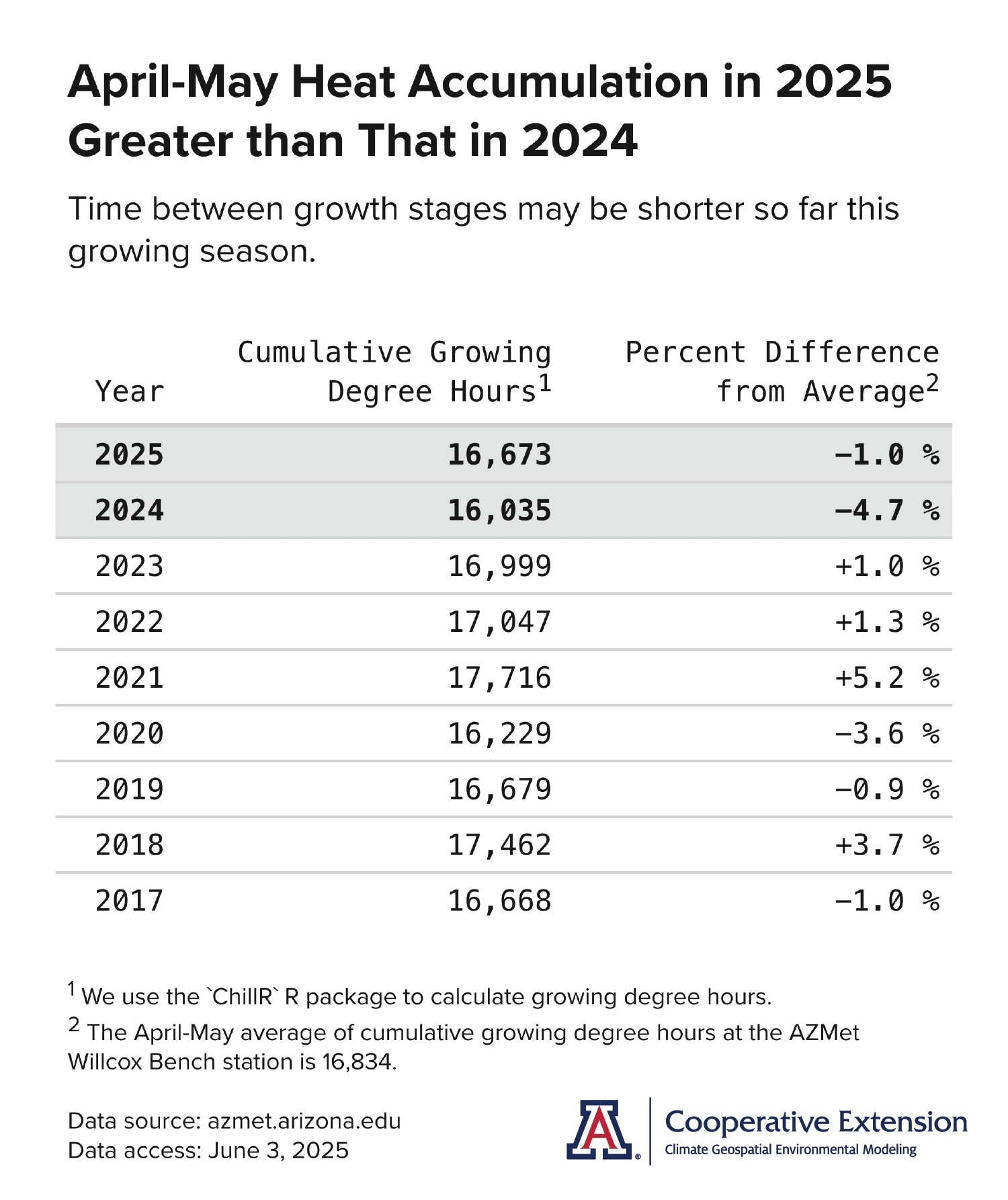
Jeremy Weiss
Extra Notes
Given recent and current conditions, there is an above-normal potential for significant wildland fires across the northwestern, central, east-central, and southeastern parts of Arizona in June. Otherwise across the state, the outlook from the National Interagency Fire Center shows potential as normal for the month.
There is a new online resource for the most recent 15-minute data from stations across the Arizona Meteorological Network, AZMet in Real-time, including the Bonita and Willcox Bench stations in the Willcox AVA.
Neither El Niño or La Niña look to affect the monsoon this summer. There is 92 % chance that ENSO-neutral conditions remain for the rest of the May-through-July 2025 period. Chances are greater than 50 % chance that they persist through the August-through-October 2025 period.
For those of you in southeastern Arizona, including the Sonoita and Willcox AVAs, Cooperative Extension manages an email listserv in coordination with the Tucson forecast office of the National Weather Service to provide information in the days leading up to agriculturally important events, like heat waves and high-wind days. Please contact us if you'd like to sign up.
And for those of you in north-central and northeastern Arizona, including the Verde Valley AVA, Cooperative Extension also now manages an email listserv in coordination with the Flagstaff forecast office of the National Weather Service to provide similar information for this part of the state. Please contact us if you'd like to sign up.
Undergraduate students in the College of Agriculture and Life Sciences at the University of Arizona are looking for internships with businesses and companies in the viticulture and winery industries. Please contact Danielle Buhrow, Senior Academic Advisor and Graduate Program Coordinator in the Department of Agricultural and Resource Economics, for more information.
Please feel free to give us feedback on this issue of the Climate Viticulture Newsletter, suggestions on what to include more or less often, and ideas for new topics.
Did someone forward you this newsletter? Please contact us to subscribe.
Have a wonderful June!
With current and past support from:



